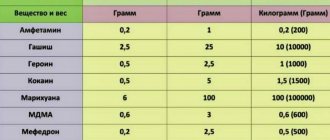ST 229.1 of the Criminal Code of the Russian Federation . Smuggling of narcotic drugs, psychotropic substances, their precursors or analogues, plants containing narcotic drugs, psychotropic substances or their precursors, or their parts containing narcotic drugs, psychotropic substances or their precursors, tools or equipment under special control and used for the manufacture narcotic drugs or psychotropic substances
1. Illegal movement across the customs border of the Customs Union within the EurAsEC or the State border of the Russian Federation with member states of the Customs Union within the EurAsEC of narcotic drugs, psychotropic substances, their precursors or analogues, plants containing narcotic drugs, psychotropic substances or their precursors, or their parts containing narcotic drugs, psychotropic substances or their precursors, instruments or equipment that are under special control and used for the manufacture of narcotic drugs or psychotropic substances - is punishable by imprisonment for a term of three to seven years with a fine of up to one million rubles or in the amount of wages or other income of the convicted person for a period of up to five years or without it and with or without restriction of freedom for a period of up to one year.
2. The same act committed: a) by a group of persons by prior conspiracy; b) by an official using his official position; c) in relation to narcotic drugs, psychotropic substances or their analogues, plants containing narcotic drugs, psychotropic substances, or their parts containing narcotic drugs or psychotropic substances in a significant amount - shall be punished by imprisonment for a term of five to ten years with a fine in the amount of up to one million rubles or in the amount of wages or other income of the convicted person for a period of up to five years or without it and with or without restriction of freedom for a period of up to one and a half years.
3. Acts provided for in parts one or two of this article, committed in relation to narcotic drugs, psychotropic substances, their precursors or analogues, plants containing narcotic drugs, psychotropic substances or their precursors, or their parts containing narcotic drugs, psychotropic substances or their precursors, in a large amount - shall be punishable by imprisonment for a term of ten to twenty years with a fine in the amount of up to one million rubles or in the amount of the wages or other income of the convicted person for a period of up to five years or without it, and with restriction of freedom for a term of up to two years or without it.
4. Acts provided for in parts one, two or three of this article, committed: a) by an organized group; b) in relation to narcotic drugs, psychotropic substances, their precursors or analogues, plants containing narcotic drugs, psychotropic substances or their precursors, or their parts containing narcotic drugs, psychotropic substances or their precursors, in an especially large amount; c) with the use of violence against a person exercising customs or border control - shall be punishable by imprisonment for a term of fifteen to twenty years with a fine in the amount of up to one million rubles or in the amount of the wages or other income of the convicted person for a period of up to five years, or without it. and with restriction of freedom for a term of up to two years or without it or life imprisonment.
What is smuggling
Article 229.1 of the Criminal Code of the Russian Federation contains the following list of prohibited items:
- Psychotropic and narcotic substances, their analogues and precursors.
- Plants, which may contain substances from the first point, or parts of these plants.
- Equipment used for the manufacture of prohibited substances.
The Criminal Code of the Russian Federation understands drug smuggling as the illegal transfer of specified substances and objects through a border checkpoint.
Commentary to Art. 229.1 of the Criminal Code
1. The subject of the crime is: narcotic drugs; psychotropic substances; their precursors or analogues; plants containing narcotic drugs, psychotropic substances or their precursors, or parts of these plants; tools or equipment that are under special control and used for the manufacture of narcotic drugs or psychotropic substances (see comments to Articles 228, 228.2, 228.3 of the Criminal Code).
2. The article applies to the circulation of precursors included in List I and Table I of List IV of the List of Narcotic Drugs, Psychotropic Substances and Their Precursors Subject to Control in the Russian Federation, approved by Decree of the Government of the Russian Federation of June 30, 1998 N 681.
3. The objective side is expressed in the illegal movement across the customs border of the Customs Union or the State border of the Russian Federation with member states of the Customs Union of items specified in the law (see commentary to Article 226.1 of the Criminal Code).
Corpus delicti
The structure of the offense is of a material nature. Criminal liability for smuggling of narcotic drugs and psychotropic substances is provided after the illegal goods have been transported across the border zone.
Psychotropic substances can be transported in completely different ways, for example, through secret pockets in a suitcase or bag, various objects, or even in the body of a person or animal. For the law, the method of transportation does not matter, only the presence of direct intent is important.
Important! Persons over 16 years of age are held liable.
When an act is considered a crime
In order for an offense to fall under Article 229.1 of the Criminal Code of the Russian Federation, it is necessary that the attacker manages to pass through checks at the border and bring prohibited goods into the country. If this condition is not met and he is caught at the time of the search, such an act will be considered at the stage of completion and a different measure of responsibility will be imposed for it.
There are cases when criminals resort to other methods of movement, such as false declarations, to commit smuggling. In such circumstances, smuggling will be considered as a completed act only after these false documents authorizing the passage of the illegal goods through the border point are handed over to the customs authority.
Objective side
The fact of transporting prohibited powders, plants, and devices for their creation through the border zone is considered a crime. The method of movement does not matter.
The object of the crime is the health of citizens of the Russian Federation and foreigners, the level of public morality and order in the country.
Subjective side
The subjective side of the offense consists in the presence of deliberate malicious intent on the part of the suspect. This means that the investigation will have to identify and prove his selfish intentions during the case.
The subject of the crime must be a sane person who has reached the age of 16.
Possible problems in the evidential part
Most often, the investigation faces problems in the evidentiary part regarding smuggling by mail. So, for example, the concepts of “shipment” and “smuggling” may not be considered as equivalent. To solve such offenses, one should be guided by the definition from the Customs Code.
There may also be a problem in applying the provisions of the institution of complicity. The actions of the recipient cannot always be correlated with the actions of the sender; prior conspiracy requires proof.
Qualification of the crime
Qualifying characteristics are determined by Part 2 of Art. 229.1 of the Criminal Code of the Russian Federation. These include committing a criminal act:
- A deliberately cooperative group of citizens.
- An official using his official position.
- Concerning the transportation of drugs or psychotropic powders or substances similar in their properties in large doses.
Particularly qualifying features are contained in parts 3 and 4 of Art. 229.1 of the Criminal Code of the Russian Federation. They determine responsibility for drug smuggling on a particularly large scale, as well as by an organized group using violence against the person conducting customs control.
Often, offenses in this area are extremely confusing. It is very rare to catch the real criminals at the head of the gang. More often, insignificant figures, performers, are put on trial, and the chain of participants in an organized gang is broken.
To decide how to qualify a person’s unlawful act, first of all, it is necessary to identify the ownership of prohibited items. There are cases when people are given various packages or objects, the presence and contents of which they are not aware of.
Important! You can learn more about these qualification criteria in the resolution of the Plenum of the Supreme Court of the Russian Federation dated April 27, 2017 No. 12 “On judicial practice in cases of smuggling.”
Commentary on Article 229.1 of the Criminal Code of the Russian Federation
1. The crime encroaches on two objects: the first is social relations that characterize the safety of public health; the second is the established procedure for moving across the customs or state border the means, substances, their analogs and precursors specified in the commented article, plants (their parts), as well as tools and equipment that are under special control and used for the manufacture of narcotic drugs or psychotropic substances.
The characteristics of the subject of the crime generally coincide with its characteristics in crimes under Art. Art. 228, 228.2 and 231 of the Criminal Code. Effect of Art. 229.1 applies to the turnover of precursors included in tables I and II of List IV of the List of narcotic drugs, psychotropic substances and their precursors subject to control in the Russian Federation, approved by the Government of the Russian Federation.
2. The objective side is expressed in the illegal movement across the customs border of the Customs Union or the State border of the Russian Federation with member states of the Customs Union within the framework of the EurAsEC of the items specified in the commented article.
The content of the act was revealed when analyzing the corpus delicti under Art. 226.1 CC.
3. The crime has a formal composition and is considered completed from the moment the act specified in the law is committed.
4. The subjective side is characterized by guilt in the form of direct intent. The motive and purpose may be taken into account when determining the type and amount (term) of punishment.
5. The general subject of the crime is a person who has reached the age of 16 years.
6. In part 2 of Art. 229.1 provides for the following qualifying criteria: a) by a group of persons by prior conspiracy; b) by an official using his official position; c) in relation to narcotic drugs, psychotropic substances or their analogues, plants or their parts containing narcotic drugs or psychotropic substances in a significant amount. The first two of them have the same content as in other crimes, where they are used to differentiate responsibility.
Significant, large (part 3) and especially large size (clause “b”, part 4 of article 229.1) of the specified means and substances, plants or their parts, precursors are approved by the Government of the Russian Federation.
An organized group (clause “a” of part 4 of the article under comment) is understood in the same way as in other crimes.
The use of violence against a person exercising customs or border control (clause “c” of Part 4 of the commented article) covers beatings and causing any serious harm to health.
What punishment does the convicted person face?
Criminal penalties for drug smuggling vary; their application depends on the qualifying features of the offense. In general, they are divided into the following types:
- In case of unauthorized movement of prohibited substances, precursors, plants that may contain prohibited substances, tools for their creation, the convicted person receives a prison sentence of 3-7 years with or without restriction of freedom of movement to one year.
- Transportation of prohibited substances, organized by a group of persons or an employee taking advantage of his official position, or passage through customs with a particularly large amount of a prohibited substance is punishable by a prison term of 5 to 10 years with or without restriction of freedom of up to one and a half years.
- Drug smuggling on an especially large scale is punishable by imprisonment from 10 to 20 years and restriction of freedom for two years or without it.
- Carrying prohibited substances by an organized group in large quantities with the use of violence against a customs officer entails imprisonment from 15 to 20 years, with the addition of restriction of freedom for a period of two years or life imprisonment at the discretion of the court.
In addition to detention, the offender may be fined up to 1 million rubles or the amount of his salary or other income for up to five years. Lot sizes are measured in accordance with Decree of the Government of the Russian Federation dated October 1, 2012 No. 1002.
When the article does not apply
If the smuggling was carried out by a person who was not in collusion with a criminal group and did not realize at all that he was transporting prohibited substances, then, according to Art. 229.1 of the Criminal Code of the Russian Federation, his act will not be qualified as a violation. But the organizer who sent this person across the border with a prohibited substance will be charged under the article in question.
Second commentary to Art. 229.1 of the Criminal Code of the Russian Federation
1. For the subject of this crime, see comments to Art. 228 CC.
2. The objective side is the illegal movement of funds, substances or items listed in the disposition across the customs border of the Customs Union within the EurAsEC or the State border of the Russian Federation with the member states of the Customs Union within the EurAsEC. Their movement is illegal if it is carried out:
a) in addition to customs control;
b) with concealment from customs control; c) with non-declaration;
d) with false declaration;
e) with fraudulent use of customs documents;
f) with the illegal use of customs identification means.
3. The crime is completed at the moment of actual movement of the contraband item across the customs (or State) border.
4. From the subjective side, the crime is characterized by direct intent.
5. The subject of the crime is a person who has reached the age of 16 years.
6. Qualified types of crime (Part 2) are characterized by its commission:
a) by a group of persons by prior conspiracy;
b) by an official using his official position; c) in relation to narcotic drugs, psychotropic substances or their analogues, plants containing narcotic drugs, psychotropic substances, or their parts containing narcotic drugs or psychotropic substances, in a significant amount.
The content of the first two signs is disclosed in the comments to Art. 229 CC. A significant amount in relation to this article is determined in accordance with Decree of the Government of the Russian Federation of October 8, 2012 No. 1020.
7. The large amount of smuggling (part 3) should also be established on the basis of Decree of the Government of the Russian Federation of October 8, 2012 No. 1020.
8. Part 4 provides for three particularly qualified types of smuggling of relevant funds, substances or objects.
9. On the concept of an organized group, see Part 3 of Art. 35 of the Criminal Code.
10. Particularly large size must be determined in accordance with Decree of the Government of the Russian Federation dated October 8, 2012 No. 1020.
11. The use of violence against a person exercising customs or border control means the commission of any acts of physical violence (restriction of freedom, beatings, causing any serious harm to health).
Arbitrage practice
In judicial practice, one can find precedents when an offense was considered minor. For example, the Presidium of the Moscow City Court, considering case No. 40/u-33/11, ruled that the suspect, having flown to Moscow, was detained during a customs check, since a dark brown substance similar to narcotic.
The examination determined hashish weighing 0.06 g. A criminal case was initiated, the accused was found guilty. But the higher court overturned this decision because it regarded the crime as minor. It did not show any signs of particular danger and did not cause harm to other citizens or the state. The criminal case was dropped.






